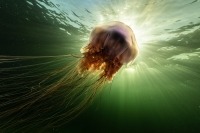
(Photo: Nick Hawkins)
Lion's Mane Jellyfish
Cyanea capillata
One of the largest species of sea jelly. It has a distinctive mass of long, thin, hair-like tentacles and a saucer-shaped bell, known as the umbrella. The bell is yellowish-brown or reddish and can typically be 30 to 50 centimetres in diameter. Individuals can grow to over 200 centimetres; the largest recorded specimen had a bell 2.3 metres in diameter and tentacles 37 metres long. The bell margins have eight groups of hollow tentacles, each containing 70 to 150 or more tentacles within it. Its oral arms are thick, frilled, and folded.
Authority
Linnaeus, 1758
Classification Details
Phylum: Cnidaria (Cnidarians); Class: Scyphozoa (true jellies).
Habitat
Found in cooler waters of the Atlantic and Pacific Oceans, the Baltic and North Seas, and the Irish Sea. In the northwest Atlantic, its range extends from Labrador to Cape Hatteras. They usually remain near the surface, at depths shallower than 20 metres. They are sighted more in late summer and autumn when currents sweep them towards shore.
Diet
Prey on zooplankton such as small fish, other jellies, shrimp, copepods, and rotifers. The sea jelly catches its prey by sinking slowly, and animals become trapped inside its tentacles. Small stinging cells called nematocysts cover the tentacles. When a prey item triggers them, they eject microscopic poison-tipped barbs that paralyze or kill the prey.
Reproduction
The sexes are separate, and fertilization is external. The female jellyfish carries fertilized eggs in its tentacles, where they grow into larvae. When they are old enough, they swim away and attach onto a hard surface. Here the larvae grow into polyps (looking a little like sea anemones). The polyps then reproduce asexually by strobilation where they divide their body into segments. Each segment becomes a swimming ephyra larva. The ephyra larvae then develop into the adult medusa form that we recognize as sea jellies. Lives for around 1 year.
Fun Facts
They have a very severe sting. In humans, this can cause blisters, irritation, muscular cramps, and can also impact respiratory and heart function.
Lion's mane jellies form most of the diet of the leatherback sea turtle when it is in Canadian waters.
References
Christian JR, Grant CGJ, Meade JD and Noble LD (2010) Habitat Requirements and Life History Characteristics of Selected Marine Invertebrate Species Occurring in the Newfoundland and Labrador Region. Canadian Manuscript Report of Fisheries and Aquatic Science, no. 2925, 207pp.
Heard JR (2005) Cyanea capillata Lion’s mane jellyfish. In Tyler–Walters H. and Hiscock K. (eds) Marine Life Information Network: Biology and Sensitivity Key Information Reviews, [on–line]. Plymouth: Marine Biological Association of the United Kingdom. Available from: https://www.marlin.ac.uk/species/detail/2090 Accessed online 20 January 2020.
Memorial University of Newfoundland. Lions Mane Jellyfish. https://www.mun.ca/osc/oscedu/ccapillata.php Accessed online 20 January 2020.
Naylor B (2000) Cyanea capillata. Animal Diversity Web. https://animaldiversity.org/accounts/Cyanea_capillata/ Accessed online 20 January 2020.
Van Guelpen L, Pohle G, Vanden Berghe E and Costello MJ (2005) Marine Species Registers for the North Atlantic Ocean. World Wide Web electronic publication. http://www.vliz.be/vmdcdata/narms/


